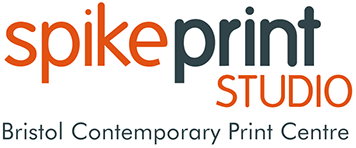History of Spike Print Studio
In 1976, Peter Reddick (founder of Spike Island Printmakers, now Spike Print Studio) and a small group of artists took on the lease of a warehouse space in the old McArthur building on Gas Ferry Road, establishing Bristol Artspace, which included the Bristol Printmakers Co-operative and studio space for about a dozen artists. The guiding principle of Artspace was that of artists collectively coming together to pool and share equipment, materials and space, and thereby creating a resource to promote greater awareness and understanding of visual art practices.
The founding of a studio and a print workshop facility was less commonplace in the 70s than it is today and at the time was no small achievement. Artspace became a voluntary community of support with a self-help ethos and rapidly expanded to accommodate a growing membership. It also became more than a just a studio provider by establishing gallery spaces, international artist exchanges, educational programmes, a sculpture workshop and public art projects. The Bristol Printmakers Co-operative played a central role in this. These were the pioneering days for what was to become known as ‘artist-led’.
When the property boom took off in the 1980s those buildings and districts that artists and arts projects had made fashionable became desirable and gentrified. Inevitably, the McArthur site was purchased by a developer and the eviction of Artspace was imminent. To prevent Artspace from being continually moved and marginalised, a campaign was launched to establish a new permanent and secure home for the project. Nobody was truly aware, at that time, what a huge undertaking this would be and how much was going to be asked of the artists. It took a decade of letter writing, fundraising, lobbying, and publicity stunts. More than 20 different buildings were pursued (some a hair’s breadth from acquisition), and close to £500,000 raised which was no mean feat in the days before lottery funding. The artists were asked to make a massive contribution towards a project for which many would not personally benefit. An atmosphere of generosity was created where people pitched in to support the campaign, motivated by the inherent value and importance of this project to generations of artists. During this development phase, Artspace also became a charity. Peter Reddick was to become a long-standing trustee and in 1996, the trustees finally managed to sign the lease on the former Brooke Bond Tea packing factory.
When Spike Island Printmakers (now SPS) moved from the Macarthur building into what is now known as Spike Island, together with artists from Top Floor and Sculpture, artists from Printmakers worked hard on a voluntary basis to fundraise, strip out the building and equip the new workshop premises on a tiny budget. It was through the hard work and commitment of members that SPS and indeed SI, have emerged. Since its inception, Spike Print Studio has changed its name twice. It started off as the Bristol Printmakers Workshop, and changed its name in 1997 to Spike Island printmakers after becoming a licencee of Spike Island ArtSpace. It has always been a membership organisation and currently has 168 members. Over the years it has grown its national reputation and is respected for its ability to support novice printmakers alongside experienced artists. Some of the members make a living by their work, and initiatives such as SPS Editions bring emerging and well known contemporary practitioners into the Studio.
With thanks to John O’Connor.
